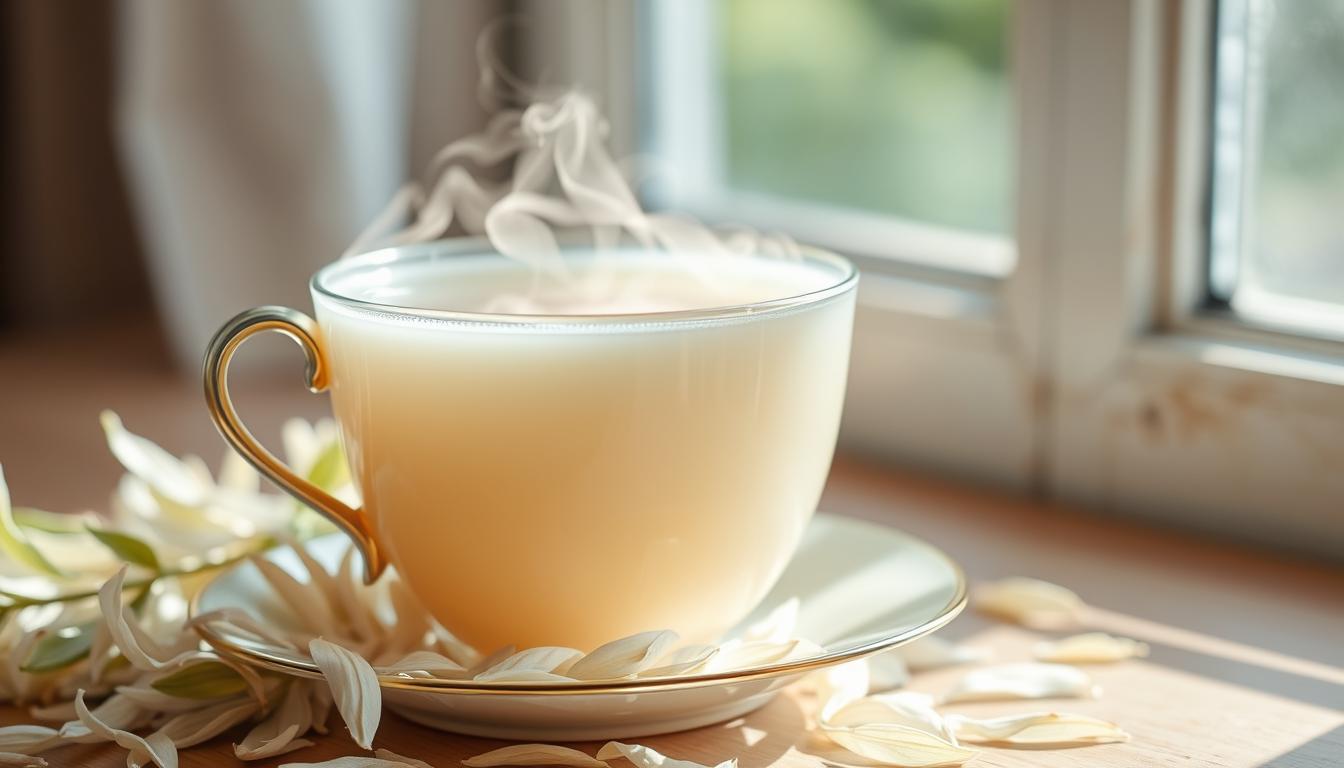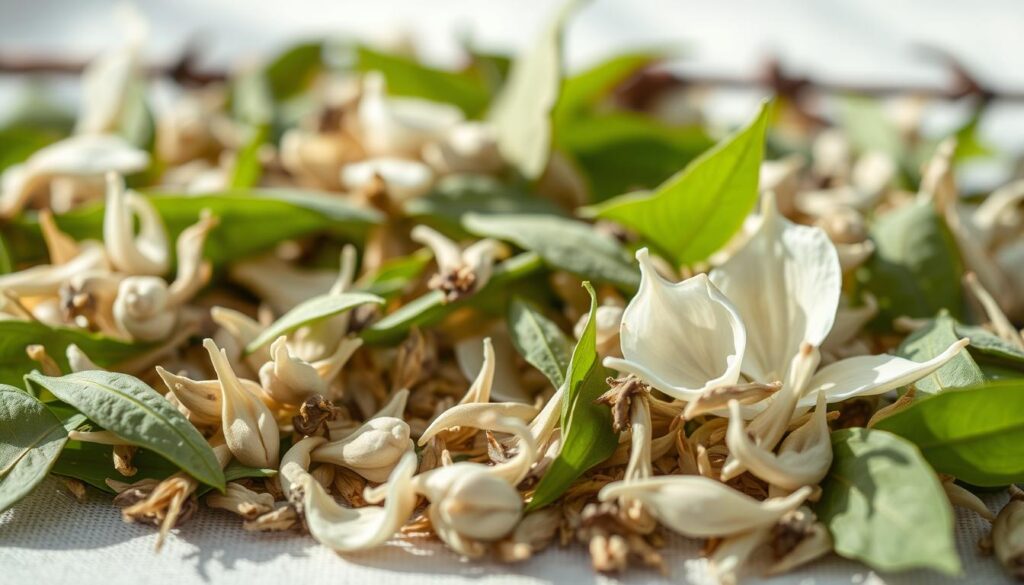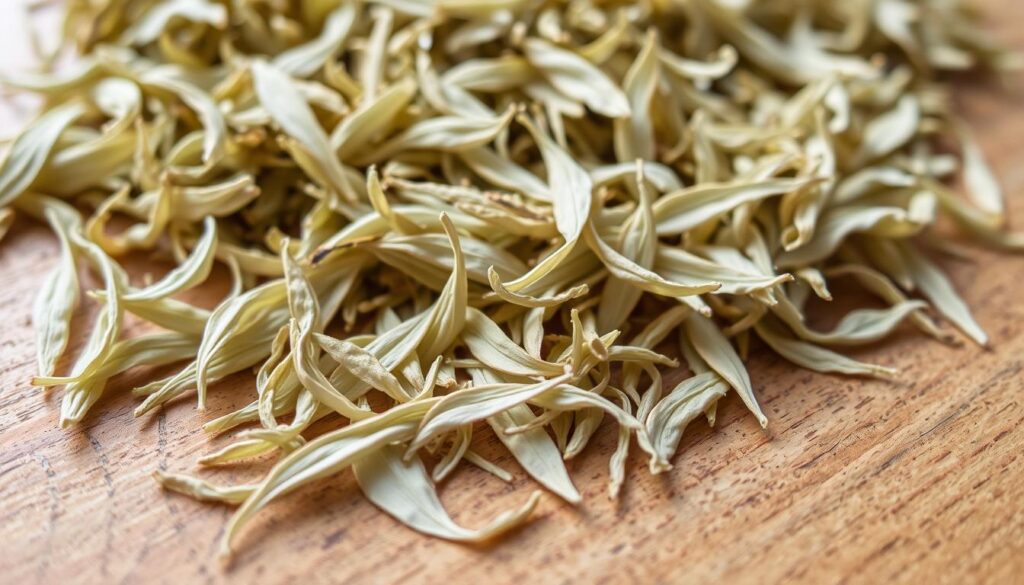As I hold a delicate porcelain cup, filled with the pale, golden liquor of white tea, I feel a sense of calm. White tea’s delicate aroma and subtle flavors take me to a peaceful place. Here, the day’s worries fade away, and I enjoy the moment.
If you love tea or are new to white tea, this guide will help you make the perfect cup. We’ll cover everything from white tea’s origins and processing to the best water temperature and steeping methods. You’ll learn how to enjoy all the health benefits and flavors of this amazing tea.
Key Takeaways
- White tea is a delicate and minimally processed with numerous health benefits.
- The recommended water temperature for brewing white tea is between 175-185°F (80-85°C).
- Use about 2 teaspoons of loose-leaf per 8 ounces of water for optimal flavor.
- Steep white tea for 2-5 minutes, depending on personal preference and type.
- Invest in premium to ensure the best flavor and health properties.
Understanding White Tea Origins and Processing
White tea comes from the Fujian province in China. It’s special because it’s processed very little. This makes it taste fresh and light.
The name “white tea” comes from the fine, silvery-white hairs on the young leaves and buds.
What Makes White Tea Special
White tea has a long history, dating back to the Tang Dynasty. It was once only for Chinese royalty. This tea is special because it’s not oxidized much.
This means it keeps lots of antioxidants and delicate flavors. The way it’s made gives it a unique taste, with a sweet and refreshing feel.
Traditional Processing Methods
Making is a careful process. The tea leaves are picked by hand in early spring. Then, they’re briefly dried to remove moisture.
Next, they’re dried again, often using charcoal. This helps keep the tea fresh and flavorful for a long time.
Types of White Tea Leaves
- Silver Needle: Made from the smallest, most tender, and silvery-white tea buds.
- White Peony: Crafted from young leaves and buds, with a slightly fuller body and sweet, floral notes.
- Long Life Eyebrow: Characterized by its long, twisted leaves and subtle, aromatic profile.
- Tribute Eyebrow: A rare and premium white tea with a complex flavor and high antioxidant content.
White tea is a true delight for lovers. Its unique processing and delicate taste offer a refreshing experience. Whether you’re new to or a seasoned enthusiast, white tea is sure to enchant you.
Essential Equipment for Brewing White Tea
To brew white tea right, you need the right tools. You’ll need a teapot or tea pitcher, best made of porcelain or glass. This keeps the tea’s delicate flavor intact. A infuser or strainer is key for white tea leaves.
A thermometer is vital for the perfect water temperature. Teabloom offers sustainable, chemical-free glass teaware for the best brewing.
White tea is the least processed from the Camellia sinensis plant. It has less caffeine than black, yellow, and green tea. The best water temperature is about 160°F (71°C). Steeping time ranges from 3 to 5 minutes, based on your taste and the tea type.
| Essential Equipment | Recommended Features |
|---|---|
| Teapot or Tea Pitcher | Porcelain or glass to preserve delicate flavor |
| Tea Infuser or Strainer | For brewing loose-leaf |
| Thermometer | Crucial for achieving the correct water temperature |
Investing in the right gear ensures a perfect white tea steeping experience. It brings out the full flavor of these delicate leaves.
“Using fresh and high-quality white tea leaves is essential for the best flavor when brewing white tea.”
Water Quality and Temperature Guidelines
Getting the perfect white tea brew starts with knowing about water quality and temperature. leaves are delicate. They need a careful approach to bring out their subtle flavors.
Ideal Water Temperature Range
The best water temperature for white tea is between 170°F and 185°F (76°C to 85°C). This range keeps the tea’s natural sweetness and aroma. Some white teas might steep best at 140°F (60°C).
Importance of Fresh, Filtered Water
Using fresh, filtered water is key for brewing tea. Don’t use water that’s been boiled and cooled. It doesn’t have enough oxygen for the tea’s flavors. Start with cold, filtered water and heat it to the right temperature.
Common Temperature Mistakes to Avoid
- Boiling water (212°F/100°C) can scald the white tea leaves. This makes the brew bitter and astringent.
- Water too cool, below 160°F (71°C), won’t extract the tea well. This results in a weak, flat flavor.
By keeping the water at the right temperature and using fresh, filtered water, you’ll enjoy a perfectly brewed white tea.
| Tea Type | Ideal Water Temperature |
|---|---|
| White Tea | 170°F – 185°F (76°C – 85°C) |
| Green Tea | 180°F – 195°F (82°C – 91°C) |
| Oolong Tea | 195°F – 205°F (91°C – 96°C) |
| Black Tea | 205°F – 212°F (96°C – 100°C) |
needs a lower temperature than other teas. This makes it a delicate and nuanced brew.
How to make a white tea?
Making a perfect cup of white tea is a fun ritual. It lets you enjoy the delicate flavors of this special tea. Whether you love tea or are trying tea for the first time, these steps will help you make it just right.
- Heat the Water: First, heat fresh, filtered water to the right temperature for white tea. This is between 170°F and 185°F. Don’t use boiling water, as it can make the tea taste bitter.
- Preheat the Teapot: Swirl hot water in your teapot or brewing vessel for about 10 seconds. Then, throw out the water.
- Measure the Leaves: Use about 1.5 teaspoons of high-quality, loose-leaf tea for every 8 ounces of water. You can adjust this based on your taste and the type of white tea.
- Steep the Tea: Put the tea leaves in an infuser and let them get used to the steam for 10-30 seconds. Then, pour the hot water over the leaves and steep for 3-5 minutes. Make sure to take out the infuser quickly to avoid bitterness.
By following these steps, you’ll unlock the sweet, floral notes of tea. Enjoy your perfectly brewed tea and enjoy the refreshing experience it offers.
“The art of preparing a good cup of white tea is a journey of discovery, where every sip unveils new layers of complexity and delight.”
Perfect Tea-to-Water Ratio for White Tea
Making the perfect cup begins with the right tea-to-water ratio. The usual ratio is 1.5 teaspoons of loose white tea leaves for every 8 ounces of water. But, this can change based on the type and your taste.
Measuring Guidelines for Loose Leaf Tea
For brewing loose leaf tea, follow these measuring tips:
- For a single 8-ounce cup, use 1.5 teaspoons of loose tea leaves.
- For a larger 32-ounce teapot, use 3-4 heaping tablespoons of loose white tea leaves.
- Adjust the amount of tea leaves based on the strength and intensity you desire.
Adjusting Ratios for Different Tea Types
The tea-to-water ratio might need to change based on the tea type:
- Leafy White Teas: These may require using slightly more tea leaves, around 2 teaspoons per 8 ounces of water.
- Bud-like White Teas: These may need slightly less tea, around 1 teaspoon per 8 ounces of water.
Try different amounts of tea leaves to find your favorite flavor and strength. For iced white tea, use 2 to 3 times as many tea leaves as for hot to get a strong taste.
Steeping Time and Techniques
Brewing requires a short steeping time to get the flavors right. It’s usually between 2 to 5 minutes. This short time helps keep the tea’s delicate flavors intact.
The best water temperature for tea is between 160°F and 180°F. Steeping for more than 5 minutes can make the tea taste bitter. To avoid this, remove the infuser gently after the right time.
White tea can be steeped multiple times, thanks to its large leaves. Teas like Organic Pai Mu Tan can be steeped up to three times. Each time, you can steep it a bit longer to get more flavor.
| Tea Type | Steeping Time | Water Temperature | Resteeping Potential |
|---|---|---|---|
| White Tea | 2-5 minutes | 160°F – 180°F | 2-3 times |
By following these tips for steeping and preparation, you can enjoy a great cup every time. It’s all about the right time and temperature.
“The secret to brewing the perfect cup of white tea lies in understanding the delicate balance of time and temperature.”
Cold Brew White Tea Method
Looking for a way to enjoy white tea’s delicate flavors without bitterness? The cold brew method is perfect. It lets the tea steep slowly in cold water, creating a smooth, balanced cup.
Benefits of Cold Brewing
Cold brewing has many perks. It pulls out less caffeine, so you get the tea’s sweetness and floral hints without jitters. Plus, it’s gentle, which means less bitterness from tannins.
Step-by-Step Cold Brew Process
- Start with about 1 tablespoon of quality white tea leaves for every 12 ounces of cold water.
- Put the tea and water in a clean glass jar or pitcher. Stir gently to make sure all leaves are covered.
- Then, cover it and chill in the fridge for 8 to 12 hours. Longer steeping means a stronger flavor.
- After steeping, strain the leaves with a fine-mesh sieve or cheesecloth. Your cold-brewed tea is now ready to drink over ice or at room temperature.
The cold brew method is easy and great for all tea lovers. Try different white teas and steeping times to find your favorite cold-brewed cup.
Making Iced White Tea
Enjoy the delicate, refreshing taste of white tea even during the warmer months by making a batch of iced . This easy method lets you enjoy white tea’s subtle flavors in a chilled, refreshing way.
To make iced white tea, start with the hot method but use 2 to 3 times as many leaves. Steep the tea for 3 to 5 minutes, then remove the leaves. Move the hot tea to a large vessel and chill it quickly with ice. As the ice melts, it will balance the tea, making it perfect for ice.
You can also make “ice tea” by brewing a stronger batch of hot white tea. Let it cool in the fridge before serving over ice. This way, the tea develops its full flavor as it cools.
For the best iced , use fresh, filtered water and brew at 175 degrees Fahrenheit. Use 2 to 3 teaspoons of loose-leaf per 8-ounce cup of water.
Iced white tea is a refreshing and healthy choice for warm months. Try different white tea varieties and brewing methods to find your favorite iced white tea.
Flavor Enhancement and Serving Suggestions
White tea is often enjoyed on its own to appreciate its subtle sweetness. But, some like to add natural ingredients to enhance the flavor. A slice of lemon, a drizzle of honey, or a bit of sugar can add to the taste without overpowering it. It’s best to avoid adding milk, as it can hide the tea’s delicate flavors.
For a unique taste, try flavored white teas. These teas are infused with natural essences like peach, pineapple, lychee, grape, or orange. They offer a variety of delightful flavors. Serve hot white tea right after brewing. Enjoy iced versions chilled over ice.
Natural Flavor Additions
- Lemon slices
- Honey
- Raw sugar
- Fresh mint leaves
- Edible flowers (e.g., chamomile, rose)
- Cinnamon sticks
- Ginger slices
Proper Serving Temperature
To enjoy white tea’s subtle nuances, serve it at the right temperature. Hot white tea is best enjoyed right after brewing. Iced is perfect chilled over ice. The flavors are best when the temperature is just right, not too hot or too cold.
Conclusion
Learning to brew white tea lets you enjoy its light flavors and health perks. Use the right water temperature, amount, and steeping time for the best white tea. Try hot, iced, or cold brew to find your favorite way to enjoy it.
White tea is great for everyone, from beginners to tea lovers. It’s low in caffeine, sweet, and packed with antioxidants. This makes it a calming and refreshing drink for any time of day.
Mastering tea brewing opens up its amazing benefits. Explore and find how you like it best. Make white tea a part of your daily life.
FAQ
What makes white tea special?
White tea is a delicate drink known for its subtle taste and health benefits. It’s made with minimal processing. This keeps its natural flavor and antioxidants intact.
What are the different types of leaves?
White tea comes from the Fujian province in China. It’s made from young leaves and buds of the Camellia sinensis plant. Shou Mei is a common type used in flavored white tea blends.
What equipment is needed to brew ?
You’ll need a teapot or pitcher, preferably porcelain or glass. Also, a tea infuser or strainer for loose leaf tea. And a thermometer to get the water just right.
What is the ideal water temperature for brewing white tea?
The best water temperature for is between 170°F and 185°F (76°C to 85°C). Some teas might steep better at 140°F (60°C).
How do you brew white tea?
First, heat fresh water to the right temperature. Use 1.5 teaspoons of loose leaf tea for 8 ounces of water. Let the leaves get used to the steam for 10-30 seconds before pouring the hot water. Steep for 3-5 minutes.
What is the perfect tea-to-water ratio for white tea?
The usual ratio is 1.5 teaspoons of loose leaf tea per 8 ounces of water. But, it can change based on the tea type and your taste.
How long should you steep white tea?
White tea steeps for a shorter time than other teas. Steep for 2 to 5 minutes, depending on how strong you like it. Never steep it for more than 5 minutes with hot water.
Can you cold brew white tea?
Yes, cold brewing is a method that gives a balanced flavor without bitterness. Use about 1 tablespoon of tea per 12 ounces of cold water. Let it sit in the fridge for 8 to 12 hours.
How do you make iced white tea?
For iced , use the hot brewing method but add more leaves. Steep for 3 to 5 minutes, then quickly chill the tea with ice.
Can you add anything to white tea?
White tea is often enjoyed plain to enjoy its subtle sweetness. But, some like to add lemon, honey, or a bit of sugar. Flavored white teas, like peach or lychee, also offer unique tastes.



